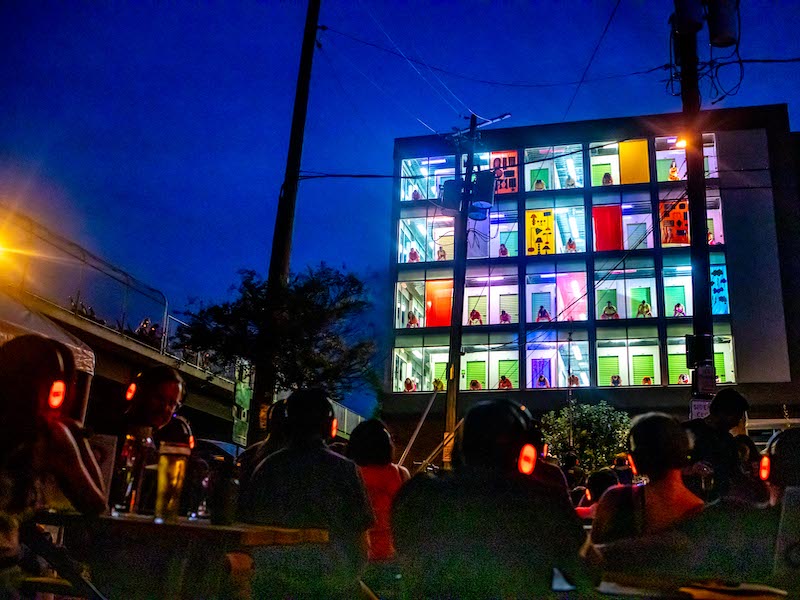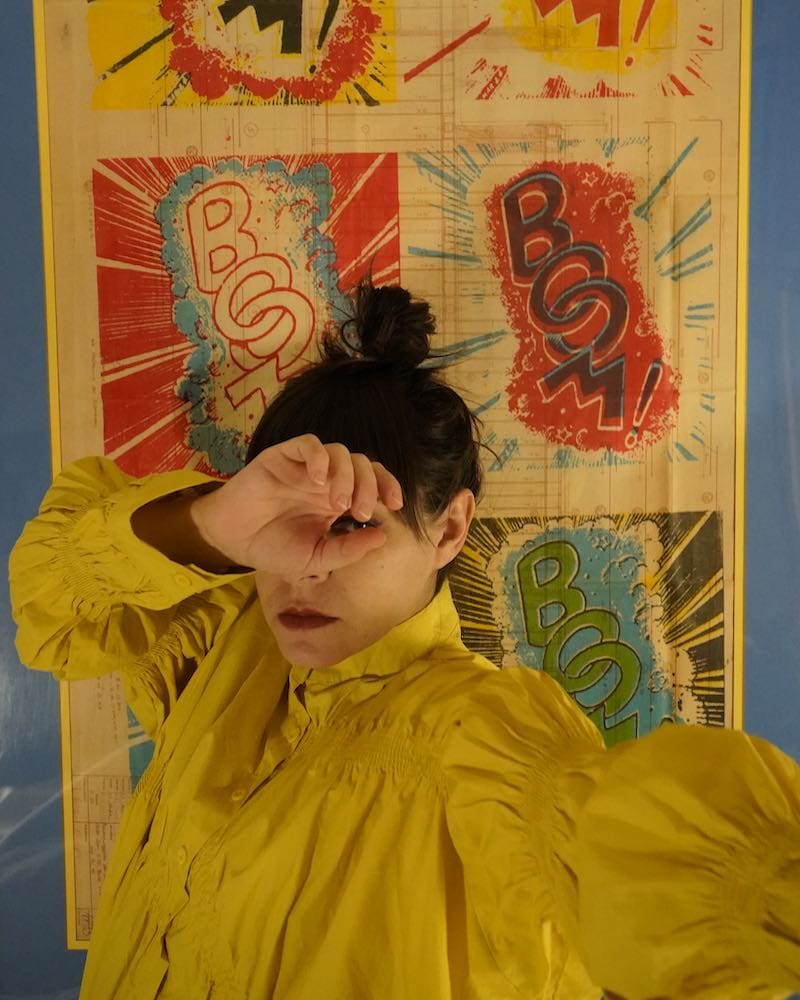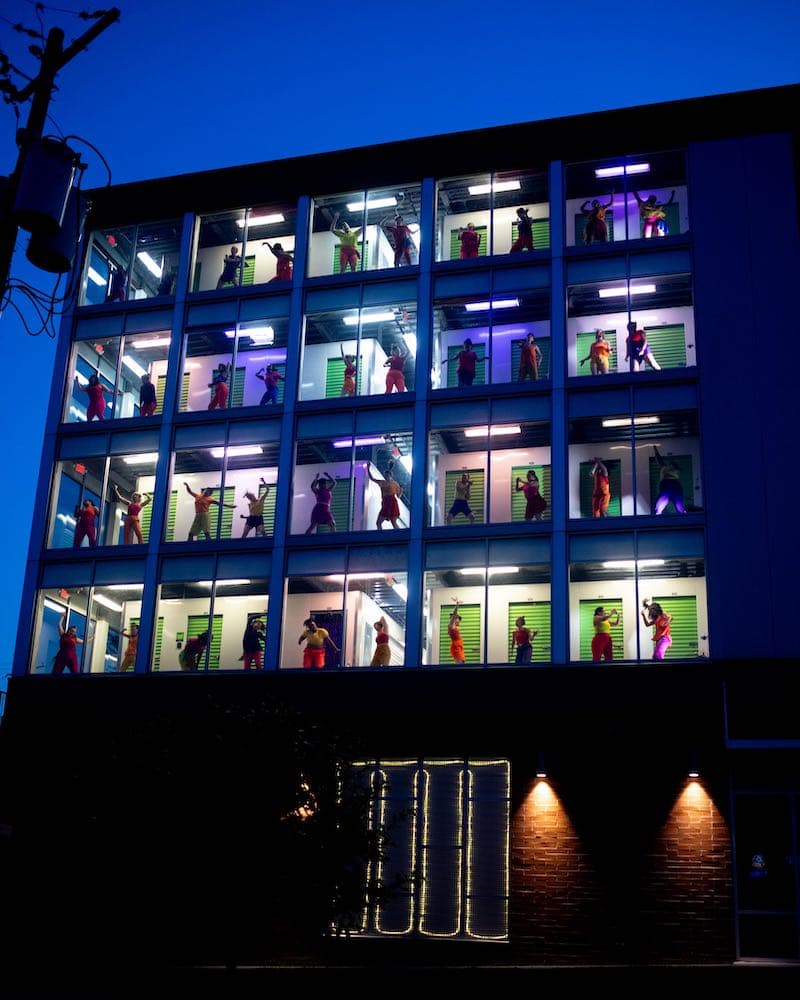It’s been a while — a long while — since I saw a locally produced, original choreographic work that wowed me. Saturday night July 8, 2023, I was wowed. As I sat on the Franklin Street NE bridge pedestrian walkway, facing the rectangular industrial Extra Space Storage building on 8th Street, waiting for the sun to set, I donned “silent disco” headphones and bobbed my head to the beat. The music, edited by Oliver Mertz, ranged from Bela Bartok to Ethiopian musician Mulatu Astatke to pop band Animal Collective and Ukrainian group DakhaBrakha to name a few of the eclectic choices. Traffic whizzed by on the bridge, leftover illegal fireworks boomed in the distance, a siren screamed, and on railroad tracks parallel to 8th Street, trains rumbled by.
As the sky darkened, the 20 windows of Extra Space Storage brightened, then music pumping, at once 40 dancers filled the 4 x 5 grid of windows, bopping in brightly colored separates of red, yellow, and orange. Many Extra Only More unfurled as a massive and wow-inducing site-specific piece from the marvelously imaginative and generative mind of Silver Spring–based choreographer Sarah Beth Oppenheim, who leads ten fearless dancers of her company Heart Stück Bernie. Many Extra Only More begins like a romp. You can’t help but smile and wish you were up there dancing with them.

But there they are, each in a separate window box, brightly lit, smiling. Together and alone. And soon the primary colors and vivid playfulness, quirky, tick-like gestures and poses, take on moodier shadings. It’s not so long ago, as memory serves, we were all living in and in front of computer-lit boxes, isolated in our homes but distantly together in our Zoom rooms at the peak of the COVID-19 pandemic. Oppenheim’s choreography does those quick tone shifts often, and well. She’ll make a ridiculously cute set out of cardboard cut-out shapes — oversized paper-doll dresses, puffy armchairs, yellow suns and crescent moons, rainbows and stars — or reams of paper with childlike drawings or PowerPoint-like instructions for the audience. She crafts as if Martha Stewart taught kindergarten and her dances emote an unspoken language filled with silent action verbs; dancers skip and hop, slink and saunter, shimmy and slither, ooze and vibrate, twitch and punch, bounce and breathe. Oppenheim has some of the quirky bright cheerfulness along with the millennial zeitgeist of sitcom actress and musician Zooey Deschanel that belie her own bright smile and vivid thrift store wardrobe.
Oppenheim has been an artist-in-residence at Dance Place — the producer of this outsized, and outside, evening — and has presented work on its stage. Her choreography has also been seen in gardens and galleries — including the National Gallery of Art’s East Wing — alleyways and storage closets. She sees dance in life’s most ordinary moments and elevates those mundanities with movement and visions of how living and dancing deeply intertwine. Her work in the community with its light and dark tones and its serious fun is her way of spreading the gospel of creative thinking to the masses.
Saturday night Many Extra Only More addressed multiple ideas in its 50 fast-moving minutes. Audiences had to come to terms with the caveat that they wouldn’t see everything. A pre-show announcement noted that no spot would allow viewers to see it all completely, and they were welcome to move around throughout the show. Sitting on what I believed were prime “balcony seats” on the Franklin Street NE bridge made me wish I was below, across the street at the Dewdrop Inn looking head-on at the dancers filling the windows. But I was quickly reminded of Merce Cunningham’s Events where dancers populated public spaces and you couldn’t catch it all, intentionally. Oppenheim’s work also nodded to another mid-20th-century modern dance choreographer, Anna Sokolow, whose acclaimed Rooms explored the isolation individuals felt in their massive apartment buildings: living in tight clusters, but each alone in their singular rooms. Marcel Duchamp’s readymades — found objects displayed as art — also came to mind with the readymade non-theatrical setting and set pieces — ordinary stuff you would find in a storage unit. Or maybe that’s a nod to the hit show Storage Wars. No matter, Oppenheim knows what she’s doing at every moment of this large-scale romp and rumination.

Many Extra Only More spooled out episodically in those window frames, vertically, horizontally, diagonally, and randomly. Oppenheim — with rehearsal assistance from Nancy Bannon and Kourtney Ginn — realized a choreographic feat in spatial organization navigating the windows like a Rubik’s cube master. Dancers shifted in groups, individuals, sometimes carrying in props, crafty cutouts, even at one point a striped sofa. Lighting by Kelly Colburn and Mark Costello used colored gels on the intense fluorescent warehouse lights, among other large-scale tricks, to shift mood and tone during the vignette-like sequences.
Moments of group synchronicity — even as dancers eschewed complete unison — conveyed celebration; a series of folk-dance–like chains and circles reminded me of a wedding or bar mitzvah. Then smaller configurations of two, three, or five reflected relational and interactive conversational moments. One dancer — Sadie Leigh — donned a green striped robe — like the green garage-like doors of the storage units — on which a collection of paper cutouts of overflow detritus were pinned: a lamp, a chair, an end table, a candlestick. Metaphorically, the choreographic structure with this oversized cast reflects the overstuffed lives so many Americans live today — homes filled with too many dishes, toys, books, sofas, and lamps, and not enough Marie Kondo self-reflection to discard what isn’t joyful. Instead, those excesses of our lives, which we can’t let go of, become a boon for the storage industry. And a reflection of the baggage we hang on to.
This is seen in moodier sections of confrontation, dancers battling as we watch — becoming voyeurs looking in from the outside. A song comes on with a violent thread as slow-motion fists and clawed hands are drawn out. A woman is splayed across a table — others manipulate her. Across the way, two dancers run themselves into the windows, again and again. Suddenly, nothing is bright or fun, sunny or sweet. Cute sun and rainbow cutouts taped to windows can’t whitewash the discord and pain surfacing in this glass-housed world Oppenheim has wrought.
The mood modulates — like life — in shifting vignettes. We follow the dance modulate from joy to pain, playfulness to violence, happiness to despair — and, finally, at the end, back to another dance-off, each dancer in her window grooving to the beat, then departing a few at a time, only to reappear on the street in front of the warehouse. The earphones still blasting music, the disco still silent, but then everyone has clumped together, and some audience members join the group. If Oppenheim wished for a big, bold, extra, supersized statement piece about the simple yet profound ways dance affects us, changes us, makes us think, moves us, and makes us move, she did it.
In recent years, we’ve seen some tectonic shifts in dance in Washington, DC, from the departure of MacArthur “genius” grantee Liz Lerman a dozen years ago, to the retirements of Dance Place co-directors Carla Perlo and Deborah Riley in 2017, to the departure of Septime Webre from the Washington Ballet that same year, and the recent untimely losses of Michele Ava, cofounder of Joy of Motion, and Melvin Deal, founder of African Heritage Dancers and Drummers. Just this year, the service organization Dance Metro D.C. closed down. Dance in the region has been on unsteady footing. Even before the pandemic shut down studios and companies for months and months, including some that didn’t survive, we were seeing fewer dance presentations in smaller venues beyond the Kennedy Center’s large stages. Dance Place’s once-weekly performance presentations have diminished to one to two performances a month.

This, Oppenheim’s largest and most complex work to date, was initially conceived in 2017, but delayed by that global pandemic. The complexities of the large working business site, technical requirements, and a massive cast for a locally produced dance company demonstrate that creative forces continue to percolate in DC’s homegrown dance community.
So Many Extra Only More bodes well for the future. Let’s hope Dance Place and the DC metropolitan dance community can take inspiration from Oppenheim’s extra-large, many-dancer production that shouts “More” with its collection of a strong cadre of young and veteran dancer/choreographer/creatives in its cast.
Many Extra Only More played July 7 and 8, 2023, presented by Dance Place performing at Extra Space Storage, 2800 8th Street NE, Washington, DC.
Many Extra Only More
Conceived and choreographed by Sarah Beth Oppenheim
FEATURING HEART STÜCK BERNIE DANCERS
Emily Ames, AK Blythe, Amber Lucia Chabus, Terra Cymek, Kate Folsom, Raeanna “Rae” Grey, Sadie Leigh, Patricia Mullaney-Loss, Nicole Sneed, Kristen Yeung
WITH
Claire Alrich, Katherine Berman, Lauren Bomgardner, Lauren Brown, Jennifer Cinicola, Sarah Coady, Annika Dodrill, Allison Grant, Safi Harriott, Jocelyn Hartman, Faryn Kelly, Betsy Loikow, Julia McWest, Bretton Mork, Simone Nasry, Annie Peterson, Sarah Raker, Jane Raleigh, Alison Waldman, Berea Whitley
AND
Elizabeth Barton, Jadyn Brick, Annie Choudhury, Lauren DeVera, Celina Jaffe, Emilia Kawashima, Luisa Lynch, Chitra Subramanian, Zoe Wampler, and Janae Witcher




